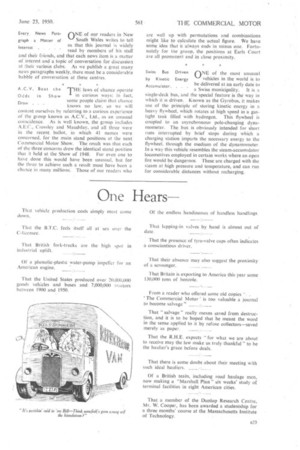Passing Comments
Page 28

Page 29

If you've noticed an error in this article please click here to report it so we can fix it.
Prophecies of 1928 CHANCING to glance at a Which Have Been '1/4' sheet of newspaper dated
Proved Wrong . . 1928 on a cupboard shelf, one of our readers found in it some interesting prophecies. One was that there would• be no place for the horse on the highways of 1938. It was added that the main roads would be marked out in strips, each to be used only by motor vehicles
travelling at a certain speed. The State would impound the licences of drivers not conforming to this speed. A broad, tree-lined grassy belt would separate the highway from sidewalks and cyclists would have to keep to their own special tracks. In addition, the Government would not, by that time, regard the Road Fund as a convenient source into which to dip for financing its adventures. Twelve years have passed since the date fixed for all these improvements, and we seem to be almost as far away from them as we were in 1928.
An Oil Engine Has 11TLE did early users of a Long Life in A-4 vehicle oil engines think Canada that within a few years a unit
of this type would be able to cover over 1,000,000 miles. This is, however, the achievement of a 1941 Leyland Tiger oil-engined bus operated in Canada by Bell Buses, Ltd., where a tax of 13 cents a gallon on commercial petrol makes the oiler even more popular. The district is hilly and seems to be well suited to the oiler. Moreover, there is a strict maintenance schedule; piston rings are replaced at 75,000 miles and the cylinder block removed at 135,000 for reboring• by 0.025 in. Later, dry sleeves are fitted and the oversize pistons turned a22
to standard for refitting. Injector units are reconditioned at 50,000 miles. Operation is complicated by extremes of temperature varying from 20 to 25 degrees F. below zero in winter and up to 90 degrees in summer. As a precaution in wet weather, the air-pressure braking system of each bus, on its return to the depot, is connected to a pneumatic, system, so as to clear the brake lines of any moisture which may have been deposited, thereby reducing risk of breakdown.
Leyland Devises A N interesting and practic Machine to Number r-k able pneumatically Screwed Studs . . . . operated machine which auto
matically impresses part numbers on screwed metal studs at the rate of 4,300 per hour has been designed and built by Leyland Motors, Ltd. Its proved success is such that other units of this type will be installed. Located near to the stud lathes, it can be fed without extra
handling and transport costs. The studs enter a chute and are picked up by metal fingers spaced around a revolving vertical drum driven at 60 r.p.m. by a fractional h.p motor. They then roll under the marking head and into a delivery chute. An air cylinder acts as a compensator, ensuring that the number is impressed to the required depth. Adjustable guides accommodate studs of I in. to / in. diameter and 11 ins. to 6 ins. length. Another method employed is electric etching; in this 'case, 15 studs can be treated simultaneously, the movement of a steel tracing pencil by the operator being transferred to a battery of needles. Every, News ParaNE of our readers in New
• -• South Wales writes to tell us that this journal is widely read by members of his staff
and their friends, and that each news item is a matter of interest and a topic of conversation for discussion at their various clubs. As we publish a great many news paragraphs, weekly, there must be a considerable babble of conversation at these centres.
Beat the THE laws of chance operate I in curious ways: in fact, some people claim that chance knows no law, so we will content ourselves by referring to a curious experience of the group known as A.C.V., Ltd., as an unusual coincidence. As is well known, the group includes A.E.C.. Crossley and Mauds1ay, and all three were in the recent ballot, in which 41 names were concerned, for the main stand positions at the next Commercial Motor Show. The result was that each of the three concerns drew the identical stand position that it held at the Show of 1948. For even one to have done this would have been unusual, but for the three to achieve such a result must have been a chance in many millions: Those of our readers who
Odds in Show Draw . . .
are well up with permutations and combinations might like to calculate the actual figure. We have some idea that it always ends in minus one. Fortunately for the group, the positions at Earls Court are all prominent and in close proximity.
NE of the most unusual '-'vehicles vehicles in the world is to
be delivered at an early date to
a Swiss municipality. It is a single-deck bus, and the special feature is the way in which it is driven. Known as the Gyrobus, it makes use of the principle of storing kinetic energy in a heavy flywheel, which rotates at high speed in a gas tight tank filled with hydrogen. This flywheel is coupled to an asynchronous pole-changing dynamometer. The bus is obviously intended for short runs interrupted by brief stops during which a charging station imparts the necessary energy to the flywheel, through the medium of the dynamometer. In a way this vehicle resembles the steam-accumulator locomotives employed in certain works where an open fire would be dangerous. These are charged with the steam at high pressure and temperature, and can run for considerable distances without recharging.












































































